PMI PMI-200 PMI Agile Certified Practitioner (PMI-ACP) Exam Practice Test
PMI Agile Certified Practitioner (PMI-ACP) Questions and Answers
An agile coach is working with a team that serves clients making product requests by phone. During a daily commitment and replanning meeting, a team member states that they were unable to resolve a client request because they lacked sufficient product knowledge.
What should the agile coach do?
An agile team has defined their definition of done (DoD) for a sprint. However, during the demo, the product owner is not sure if a user story can be marked as done.
Select the most appropriate sequence of activities that would need to be completed to meet a well-defined, mature definition of done (DoD).
The agile coach of a development team uses a servant leadership approach. The team is starting the third iteration of an upgrade to a software product, and work is going slower than initially planned.
What should the coach do to help the team?
A project's product owner asks the scrum master to facilitate the estimation activity. The scrum master then meets with the team and the product owner to clarify the user stories. Following the meeting, the team assembles and provides individual user-story estimates.
What technique did the team use?
Which option describes how risk should be managed in an agile project?
An executive requests information regarding a sprint status. What action should the product owner take?
During sprint planning the product owner wants the team to prioritize and deliver a number of features which have the highest business value. Due to technical dependencies, the team does not agree with the prioritization.
What should the project leader do?
The customer needs assistance in determining the efficiency of a set of process activities within the solution. What should the agile team do?
What is the first thing an agile development team should do when planning an iteration?
A project team held a working session with a finance team to understand the procurement process. After the meeting, while the agile lead was facilitating the value stream mapping exercise, one of the team members asked: "When calculating the cycle time, which factors should be considered?"
How should the agile lead respond?
During a daily stand up, the tester engages the developer in a discussion about what will be tested during unit testing versus regression testing. What should the scrum master do?
When working with Lean approaches, which process includes the sequence of steps for delivering value and those required to carry them out?
A new stakeholder has recently joined a project. During a meeting with the scrum master, the new stakeholder tries to understand the status of the project and the remaining tasks for completion.
How should the scrum master inform the new stakeholder?
At the retrospective, the burndown chart shows that the project is slightly behind schedule. The project team identifies an inexperienced software engineer as the source of reduced velocity. How should the project team address this issue?
A client needs to release their product to market earlier than planned. They need to start receiving the expected revenue, according to their financial forecast, which will require completing the work left on all user stories in the backlog.
What should the project lead do to accommodate this request?
A customer has difficulty explaining how the highest priority feature will work. What should the agile project manager do?
A project team is working with an enterprise agile center of excellence (CoE) to transition to a Scaled Agile Framework (SAFe). Many of the team members are not familiar with the new methodology and are worried that it will lead to more work and scrutiny.
What should the agile team lead do to help ensure a smooth transition?
More details for a story are required before the upcoming sprint planning meeting What should the scrum master do?
An employee just received an Agile certification and has been promoted to team leader. They are working on a project that is experiencing issues with late deliverables. After monitoring project progress, they notice that one impediment is continuously repeated at start of each phase, affecting team's productivity.
How should the team leader exhibit servant leadership?
A team member starts discussing a project roadblock during a daily coordination meeting. The team discusses details of the impediment, which takes up most of the meeting time.
What should the agile facilitator do?
A new product owner shares the product vision during the team launch event. The team asks for clarification on the product roadmap and its high-level features.
What should the product owner do?
An agile practitioner is working on a project to migrate data from computer systems to another location. To accomplish this task, they need to run four activities sequentially that different teams are performing. The teams are migrating two systems per day, but the agile practitioner thinks that three systems should be done per day.
What can be done to improve process efficiency?
The lead developer informed the team that they have learned of some possible integration challenges in creating customer dashboards using the architecture the team has chosen. What should an agile practitioner do?
After completing the release plan, the team realizes that the project is very likely to have a negative ROI What should the team do?
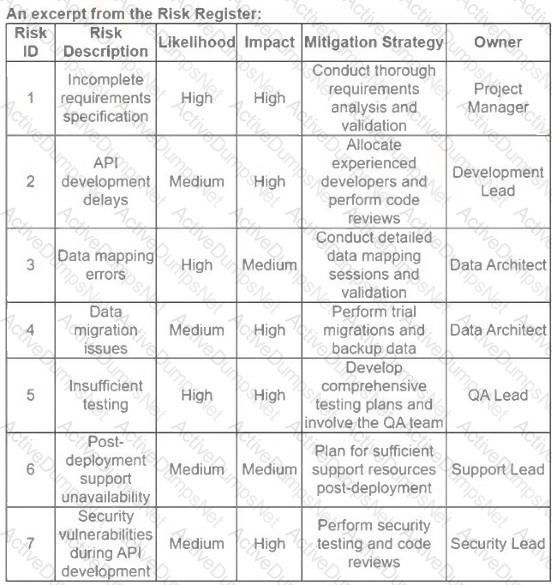
An e-commerce company acquired a tool to customize subject line generation for marketing campaigns. In sprint planning, the team discussed integrating this tool with the customer relationship management system.
Which mitigation strategy is most appropriate to ensure the final product meets the business objectives? (Refer to the Risk Register Exhibit)
A mature agile team welcomes a new member Due to poor experiences with a previous team, the new member is reluctant to communicate.
What should the agile project leader do?
Stakeholders have conflicting requirements, and the product owner is struggling to decide which user stories to write. What should the product owner do?
The project team is ahead of schedule and beginning lo gold-plate the feature included in the current sprint. What should the agile project manager do?
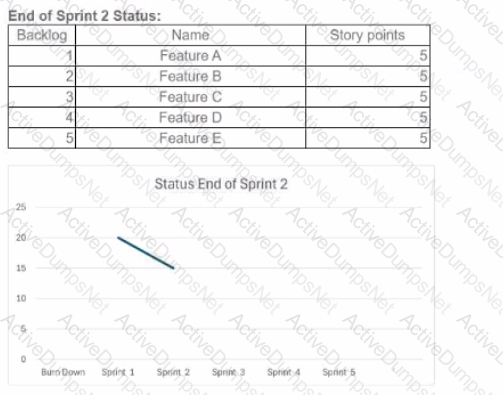
Case Study
An agile project lead for a company is leading a sales team who has committed to delivering new product functionality to the customer at the end of five sprints. The agile project lead performed initial planning with the team and with the team's support has committed to the scope and deadline.
Check in with the project in three stages to answer the associated questions.
How do two additional features and more story points added by the product owner impact the team's progress and ability to complete work within the iteration, considering the burndown rate of the team has not changed? (Refer to the Case Study and End of Sprint 3 Exhibit)
During an iteration, an agile team discovers infrastructure requirements that were not initially considered. What should the team do to effectively manage this?
A product owner asks a newly formed scrum team how many story points will be completed in a sprint. What should the scrum master do?
An experienced product owner presents the epics and corresponding stones during a release planning session with the established team. The executive sponsor asks the team when the features will be delivered.
What should the agile team do?
An agile team is under pressure to deliver an application. The product owner anticipates many change requests from customers once the product is released.
What should the agile team do?
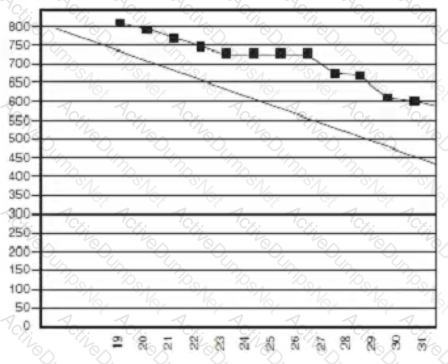
Based on the burndown chart, what is the iteration's status?
A project team has been working on five data source integrations. They have allocated one tester for each data source. One of the testers is on emergency leave for personal reasons, so the project
deliverables could not be completed on time.
How should the project team improve during their retrospective for future implementations?
A technical problem arises that will likely impact the stories planned for delivery in the current sprint What should the scrum master do?
While struggling to take ownership of delivery an agile team fails to keep up with its sprint commitments What should the agile coach do?
During iteration planning, it was determined that an epic should be decomposed What was the determining factor?
The team is derailed by a demand from a senior manager unrelated to the project. How does the agile coach help the team?
An agile lead is working with a team to deliver a new product. During a sprint, a junior team member has been taking too long to deliver a story. During daily coordination meetings, the junior team member does not mention any impediments they might be facing. Senior team members realize the delay but remain quiet. During a one-to-one conversation, the agile lead discovers the junior team member is struggling with a technical issue but feels too intimidated to ask for help.
What should the agile lead do?
An agile lead is working with a team to deliver a new product. During a sprint, a junior team member has been taking too long to deliver a story. During daily coordination meetings, thejunior team member does not mention any impediments they might be facing. Senior team members realize the delay but remain quiet. During a one-to-one conversation, the agile lead discovers the junior team member is struggling with a technical issue but feels too intimidated to ask for help.
What should the agile lead do?
An agile team notices that the same problems continue to occur during multiple iterations Several team members have suggestions to fix the problem.
What is the proper agile approach to handle this?
The team is in the middle of an iteration and there is an urgent request for a small change to be introduced to the committed scope Unless this change is accepted, there is no value to the customers during this iteration.
What must the agile practitioner do?
A product roadmap should contain which of these primary components?
After performing three sprints, the product owner and sponsor request an accurate schedule indicating when all releases will be delivered. What should the agile practitioner do?
An agile coach is working on a software development project. Their team is approaching the sprint deadline, but their client is requesting to include additional features that will bring added value.
What should the agile coach do to address this requirement?
An agile coach is working on a software development project. Their team is approaching the sprint deadline, but their client is requesting to include additional features that will bring added value.
What should the agile coach do to address this requirement?
In a scrum team, who should be responsible for the budget and release plans?
A scrum team is experiencing lengthy discussions leading to no concrete actions during their scrum events. The scrum master determines that these inefficient meetings are producing waste.
What should the scrum master do to make the meetings more efficient?
Management decides to set up a new project to exploit an emergent market opportunity. Management suggests using an agile approach that is currently working for another project.
What should the agile leader do next?
Management decides to set up a new project to exploit an emergent market opportunity. Management suggests using an agile approach that is currently working for another project.
What should the agile leader do next?
Trend analysis shows that velocity is significantly higher than predicted and the release can be completed one month ahead of schedule. The team recommends changing the end date to reflect this.
What should the agile practitioner do?
The team is aware that they will need to integrate a new component to their solution in the next few weeks. The team does not have any experience with this component.
What should the team do next?
An agile practitioner wants to communicate the effect of technical debt on the project What should the practitioner do?
Business stakeholders of an agile project frequently skip the review meetings. What should the agile practitioner do?
A team lead reviews processes and identifies bottlenecks that prevent the teams from quickly delivering minimum viable products (MVPs). Which responsibility falls within the context of servant leadership?
The systems integrator for an enterprise resource planning (ERP) project has been onboarded. During an iteration planning session, the team determines that the next highest priority item will take longer than expected to complete in the current sprint.
What should the agile practitioner do next?
During a project's last iteration, an agile team struggled with a feature's delivery due to the lack of a required skill. The project has already incurred a five-day delay. A further delay of at least 10 days is anticipated.
What should the agile project leader have done to avoid this situation?
A large project team is assigned to a complex technical project with many interdependent epics. The team starts to experience problems in the second sprint as the technical leads are independently unable to determine the needed solutions.
What should the project lead do to help the team?
What should a learn consider when calculating the effort needed to complete a product backlog?
A team member on a new scrum project previously provided support to another application Due to issues with that application, the team member's former supervisor continues assigning them tasks related to that project. The new project's scrum master includes this issue in the risk register.
What should the scrum master do next?
A new Scrum team is struggling with the various ceremonies of Scrum. Among other things, the product owner and stakeholders find the technical architecture and design presentations during sprint reviews less than informative.
What should the team do?
A development team determined the first release of a product should focus on delivering a minimally viable version of the solution. What is the most important reason the team decided to do this?
A scrum team is working together virtually. One of the team members sends a daily email to the other team members listing impediments that they find. During retrospective meetings, the team member complains that their colleagues fail to take actions on the impediments.
How should the team address this issue?
Members of an agile team are complaining that user stories are too large, taking multiple sprints to complete them. They say this way of working is becoming difficult to handle and it has been challenging to map relationships between stories. This situation is affecting the value delivery for the product owner.
What should the scrum master do to handle this situation?
During a current sprint, a team member asks permission from the scrum master to investigate an alternative design approach What should the scrum master do?
A product owner adds a 21-point, high-priority story to a sprint backlog. The team is concerned that it cannot be completed during the current sprint. What should the team do?
An agile team lead noticed their team’s velocity was slowing down. They did not deliver a working software during the last iteration and there have been miscommunications between team members.
What should the agile team lead do at the end of this iteration?
The project manager has requested that the customer participate in the requirements gathering session for the next release. A conflict comes up regarding the requirements between the customer and team.
What should the project manager do?
A project manager is managing a large complex project with cross-functional teams using an adaptive approach. Frequent communication among the team leads of these cross-functional teams is crucial for the project to stay on track and deliver value according to the project plan.
Which agile communication practice should the project manager implement to ensure the cross-functional teams interact frequently?
A new team member asks what changes could accelerate a change to the project plan What should be the proper response?
The team is working to build a new Al model that will summarize and create presentation materials for executive leaders from external and internal content. The team believes there is value in increasing the scope of work as it will benefit the organization.
Which two actions should the product owner take first? (Choose two.)
For what is the MoSCoW method used?
An agile team is struggling to achieve their goal during the first release due to an unstable environment beyond the authority of the product owner. Close to the end of the current sprint, the release manager resigns and a new person takes over.
What should the scrum master do?
An agile team is struggling to achieve their goal during the first release due to an unstable environment beyond the authority of the product owner. Close to the end of the current sprint, the release manager resigns and a new person takes over.
What should the scrum master do?
During mid-sprint changes, an agile facilitator meets with the executive and development teams. During the meeting, executive team members resolve conflicts, and on their own initiative, review the iteration charts to discuss changes to the iteration's functional goal.
What practice is the agile facilitator implementing?
A user interface (UI) developer has features for channels ready for review. During the team review, the architect is disappointed that Splunk software has not been implemented for better server and client logs. The architect insists on the implementation of Splunk software, which will impact the release date.
Which one of the following is the ideal option for the team to resolve this conflict?
An agile team and a traditional development team are working together on a project. Each team exceeds expectations regarding deliverables: however, issues arise when the deliverables are integrated. What should the agile practitioner do?
A client states that a product is not being built as requested How should the agile team address this?
A company has decided to use an agile delivery method for launching a new product to improve the customer checkout experience. How should the project manager ensure the experienced predictive delivery teams are capable of adopting the agile model?
The initial roadmap and release dates for an agile project were set based on data from similar projects and some expert opinions. Halfway through the project, however, the team’s estimates are different. Based on the team’s velocity, two more iterations were necessary to accomplish the initial scope.
How should the agile lead explain the difference to the project sponsor?
During a retrospective, team members suggest process improvement ideas. The agile team lead knows that, while many of these ideas are different from standard practices, a few of them are good. What should the agile team lead do?
A scrum master has a team of six members. The team complains they are losing time because they are attending meetings for which they see no value.
What should the scrum master do?
Several team members have complained to senior management about their scrum master's processes. What should the scrum master do to address the team's process concerns?
During a backlog refinement meeting, a senior team member raises a concern about an epic sizing that requires the use of a new interface for a vendor product. The product owner acknowledges this as a risk. What should the product owner do now?
A team member has spent 5 days on a spike and the first set of experiments has not been successful. The issue is the development team member has determined a short-term rather than a long-term solution.
What should the project leader do?
Why should an agile coach model agile principles and behaviors, become self-aware, and be present?
As user stories are developed, what should be done to record and update acceptance criteria?
A project is to be started with a team of nine existing and nine new members. The scrum master feels that the team is too large and wants to break it into three teams. The scrum master sets aconstraint that each team have an equal number of existing team members for knowledge sharing and experience.
What should the scrum master do to accomplish this?
What should an agile practitioner do to ensure that the end product meets business requirements?
A project team member expresses frustration about the length of time it takes to make decisions for a complex project. Approvals needs to happen at many levels in the company.
What should the team lead do to improve decision quality and reduce the time required to make decisions?
During the review session, the product owner discovers that the user interface has a response time of 10 seconds. The non-functional requirements state that it should respond in less than two seconds. The team complains that this requirement was not communicated to them.
What should have been done to avoid this?
Two teams have received project requirements and completed estimates. Team A estimates 420 story points for scope and 30 story points for velocity per sprint. Team B estimates 280 story points for scope and 20 story points for velocity per sprint. Both teams have same number of team members and have an assumed sprint duration of 2 weeks.
What can an agile practitioner conclude about team A and team B's estimates?
A product owner complains that some of the requirements identified several iterations ago have not been implemented. The product owner wants to know why the status of these requirements was not communicated.
What should the Scrum Master do?
A project team developer has been involved in a large corporate initiative that has negatively impacted team productivity on another project to which they have been assigned. How should the developer have handled this situation?
A scrum master is working with a team on a complex software project that is scheduled to run for 2 years with a series of product releases. The scrum master is responsible for planning the project for the next 6 months and has advised planning the project up front.
What should the scrum master do?
During a sprint demo, a business representative identifies missing requirements. The agile practitioner realizes that all key stakeholders were not included during requirements detailing.
What should the agile practitioner have done to avoid the situation?
A new project is under way and the team is using the Kanban method. One of the team members raised a specific issue related to a programming language that the team member faced in previous projects.
What should the project leader do to handle the issue?
A Kanban team is struggling to prioritize and determine which tasks to handle first according to value. What should the team do to improve this situation?
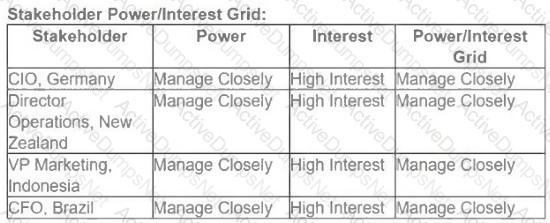
An agile development team is working on a digital transformation project and is facing challenges in obtaining consistent feedback from stakeholders who are dispersed around the world. The product owner is under pressure as this lack of engagement has led to prolonged decision-making cycles and has adversely affected the outcomes of sprints.
How should the team improve stakeholder engagement to help ensure timely feedback and better decision-making? (Refer to Stakeholder Power/Interest Grid)
DRAG DROP
All the developers on a project team are working offshore in a different time zone, resulting in many issues. Match the issues to the agile practitioner's recommendations for resolutions below. (Drag the Problems/Issues on the left to the box in the center, corresponding to the correct Recommendations for Resolution on the right)
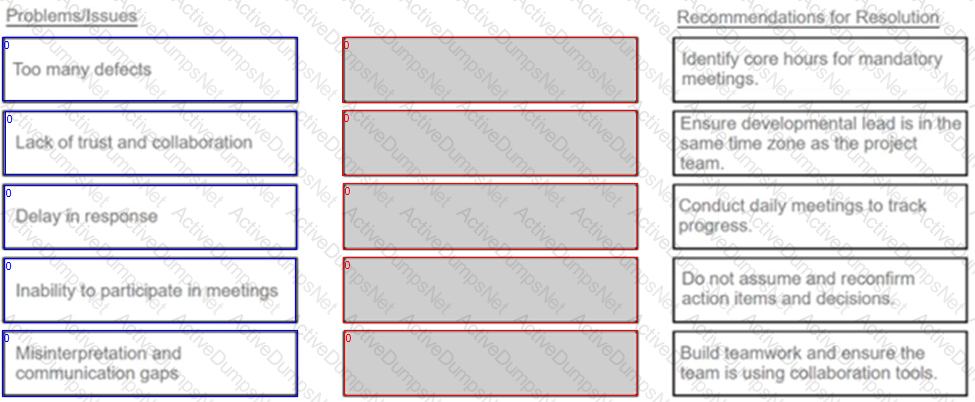
A Scrum team decided to switch to Kanban for the maintenance phase of the product. The kanban board consists of the following columns "To do," "In progress," "Ready to be tested," "Test in progress," and "Done." Since the team changed their way of working, they have noticed the work is flowing slower in the system. A large queue of "Ready to be tested" work items has been building up.
What should the team do to improve its speed of delivery?
A Scrum team decided to switch to Kanban for the maintenance phase of the product. The kanban board consists of the following columns "To do," "In progress," "Ready to be tested," "Test in progress," and "Done." Since the team changed their way of working, they have noticed the work is flowing slower in the system. A large queue of "Ready to be tested" work items has been building up.
What should the team do to improve its speed of delivery?
Part way through a project, several team members are in conflict over whether or not a deliverable has been properly completed. How should the agile leader reduce this conflict?
After three iterations, it is identified that a project's underlying security structure architecture is unstable. While there is a technical solution, all work to date is flawed. This will impact several future business service offerings.
What should the product owner do to resolve this?
A product owner has various items in a product backlog and does not know how to prioritize them. How should the agile practitioner coach the product owner?
A project manager is working on a user story about migrating to a new version of a database but is unsure of the dependencies. What can the product owner request from the team to understand the risks?
A team is transitioning from a predictive approach to an agile approach Historically, the team has delivered work products that did not meet customer expectations.
What agile practice can help the team to alleviate this?
An agile team lead is assigned to a project that must ensure data security. What should the team lead do to guarantee that security, as a non-functional requirement, is managed throughout the project?
A newly formed development team experienced difficulty with accurately estimating product backlog items. As a result, the team failed to deliver all of the features in the sprint backlog for the past two iterations.
What should the team do to improve the accuracy of their estimates?
An event management team is following an agile approach to prepare for an upcoming conference. The regional sales manager, from where the conference is to be held, contacts the team with a number of questions about the company's booth.
What should the team do?
During backlog refinement, a team routinely creates tests to demonstrate to the customer that each acceptance criterion has been met. Most acceptance tests results are observable or demonstrable, but testing for one requirement is providing a challenge to the team. The requirement states that the home button should be recognizable and the team is unsure how to test this.
What should the team lead do?
Two agile teams from different company sites need to work and collaborate on the same project. What is the first action the agile project manager should take in order to ensure a smooth collaboration between the two teams?
The transition of a monthly news publication from paper to digital is planned to start in the next few weeks. There is a debate between the product owner and the development team about the initial features to be made available and the first five stages of implementation.
What should the scrum master do to address this situation?
As a team completes their 21st sprint, new information reveals that a number of significant system integrations must be made to ensure the project scope is met. How should the project management plan be adjusted?
An agile team identifies that their velocity is lower than predicted, and that their previous forecasts in the product roadmap are wrong. The team is worried that they will be unable to meet a critical release date without corrective action.
What should the team do?
During sprint planning, team members have differing opinions on a feature that delivers business value but fails to provide a long-term solution for the customer How should the team resolve this?
A scrum master of a team that is new to Scrum wants to share the purpose of the daily coordination meeting. What should the scrum master tell the team?
A project manager is working on an agile team. A team member mentions that risks threatening the release date of the current sprint are not being addressed.
What should the project manager do to make sure team members are following up on risks?
While attending a conference, an agile practitioner learns of a new user interface (Ul) framework that could benefit the team. What should the agile practitioner do next?
During a team meeting, conflicting opinions arise regarding the best approach to complete a project task. The project manager wants to ensure that the team can effectively handle these conflicts and come to a resolution that benefits the project.
What is an effective way to handle conflicting opinions in team meetings in an agile environment?
During a team meeting, conflicting opinions arise regarding the best approach to complete a project task. The project manager wants to ensure that the team can effectively handle these conflicts and come to a resolution that benefits the project.
What is an effective way to handle conflicting opinions in team meetings in an agile environment?
The customer asked the IT project manager to change a few specifications for the software being developed, which will affect the project budget. The financial sponsor is having difficulty approving changes to the budget that was already allocated to the project.
What should the project manager do next?

Based on the backlog metrics in the chart what can explain the jump in points at the end of iteration 4?
Why is stakeholder engagement important for project success?
An agile team is planning the next iteration for a product release that has accumulated technical debt What should the team do?
A team member on a self-directed team is concerned that a feature the customer wants is outside of what the team will be able to deliver. What should the team member do next?
An agile team has received several new features to be added to the product backlog. The team is struggling to provide a reasonable estimate for feature development due to a lack of experience.
How should an experienced agile practitioner assist the team?
A customer and a product delivery team meet to discuss a product's attributes, goals expectations. hypothesis1 and high-level needs. What is a benefit of this meeting?
A product's scope and acceptance criteria have been defined, and the product is planned for release at the end of the next quarter. What should the project team do next?
A project is starting and the type of work is complex and suitable for agile in assessing the team members, it appears that co-location would be a challenge.
What should the agile practitioner do?
An agile coach has been hired to improve the performance and quality of developed software. The coach performed an analysis of the software and discovered an excessive number of escaped defects, leading to external failures.
How can the agile coach effectively address and correct defects in the software development process while maintaining predictability and keeping workloads within capacity?
A Scrum team has worked hard to reach their sprint goal, but impediments have prevented them from succeeding. The team needed help from a specialist on another team, but the specialist was on a 2-week vacation.
What should the scrum master do?
A team using Kanban identifies that their cycle time has significant variation After brainstorming the team determines that the root cause is the stones' varying sizes and risks.
What should the team do?
A project has several features that will deliver immediate customer value. The product owner needs to determine which features to include in the upcoming iteration.
What should the product owner have the customer review and approve?
What is the risk of using agile in a distributed team?
A Frequent integration of work produced
B. Lack of shared knowledge of user stories
C. Need for more locations to learn agile
D. Unclear team structure
An agile team's client has been asked to expedite the delivery of the next release. By delivering one month early, the company can generate USS40.000 more than expected for the quarter. What should the agile team do?
A scrum team is working on an important project with a short deadline. To save time and reduce overhead, the product owner proposes that the regular sprint reviews should be cancelled and replaced with a review of each release according to the release plan.
What should the scrum master do?
A large project team of 20 people from different functional areas has just been formed and the project starts next week. The team will be working on a regulated and strictly controlled pharmaceutical product but does not have subject matter expertise.
Which two actions should the scrum master take as priorities? (Choose two.)
A large project team of 20 people from different functional areas has just been formed and the project starts next week. The team will be working on a regulated and strictly controlled pharmaceutical product but does not have subject matter expertise.
Which two actions should the scrum master take as priorities? (Choose two.)
What should the agile practitioner know about tracking velocity?
A team is delivering work as per the sprint plan, and team velocity is stabilized. However, at the end of the release, the customer is dissatisfied with project quality. What should the agile project manager have done to avoid this?
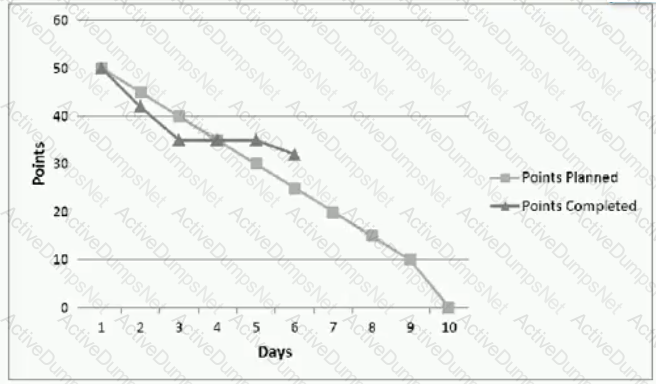
Based on the chart, what is the current status of the iteration when comparing story points planned versus completed?
An agile team is continuously interrupted by stakeholders wanting to ask product backlog questions. Distractions can have a negative impact on value delivery and quality.
Who is responsible for protecting against distractions?
As part of the organizational change, all project teams within the digital channel’s portfolio have been directed to move from 3-week iterations to 2-week iterations. The development team is frustrated as they think there will not be enough time to test. The product owner does not like this change as it will increase the number of ceremonies.
Which two actions should the scrum master take? (Choose two.)
During a Kanban team's daily stand up, an agile coach observes that the team seems disinterested in the work status. While it appears that there are no issues with flow, there is a marked lack of attention to team effort. When the agile coach queries the team for reasons, members explain that work continues to be scheduled with no end in sight.
What should the agile coach do?
The scrum master for a large project must provide an estimate of what can be delivered in six months What should the scrum master do?
A new project is scheduled to begin next month. The project manager has had plenty of time to review and plan all the activities and has adopted the best approach for the project and the organization.
Which action did the project manager most likely take when choosing the approach?
The agile team has failed to meet their iteration goal, and contention has developed between members. The agile leader would like to determine how to improve the team's productivity and morale.
How should the agile leader address this?
A new agile team is forming to address a high-priority project. Team members are dispersed over a wide geographic area. The scrum master and the team are currently defining their working agreement.
What should be part of the working agreement for a dispersed team?
The coach on a new agile team notices that one team member is influencing most of the team's decisions. What should the coach do?

 Unit testing ensures the code works as expected.
Unit testing ensures the code works as expected. Meeting the acceptance criteria ensures that the business needs are met.
Meeting the acceptance criteria ensures that the business needs are met. Business testing and functional testing confirm the product works from both the business and technical perspectives.
Business testing and functional testing confirm the product works from both the business and technical perspectives. Code merging ensures that the feature is integrated into the main branch.
Code merging ensures that the feature is integrated into the main branch. Updating documentation ensures that the product is well-documented for future reference and use.
Updating documentation ensures that the product is well-documented for future reference and use.